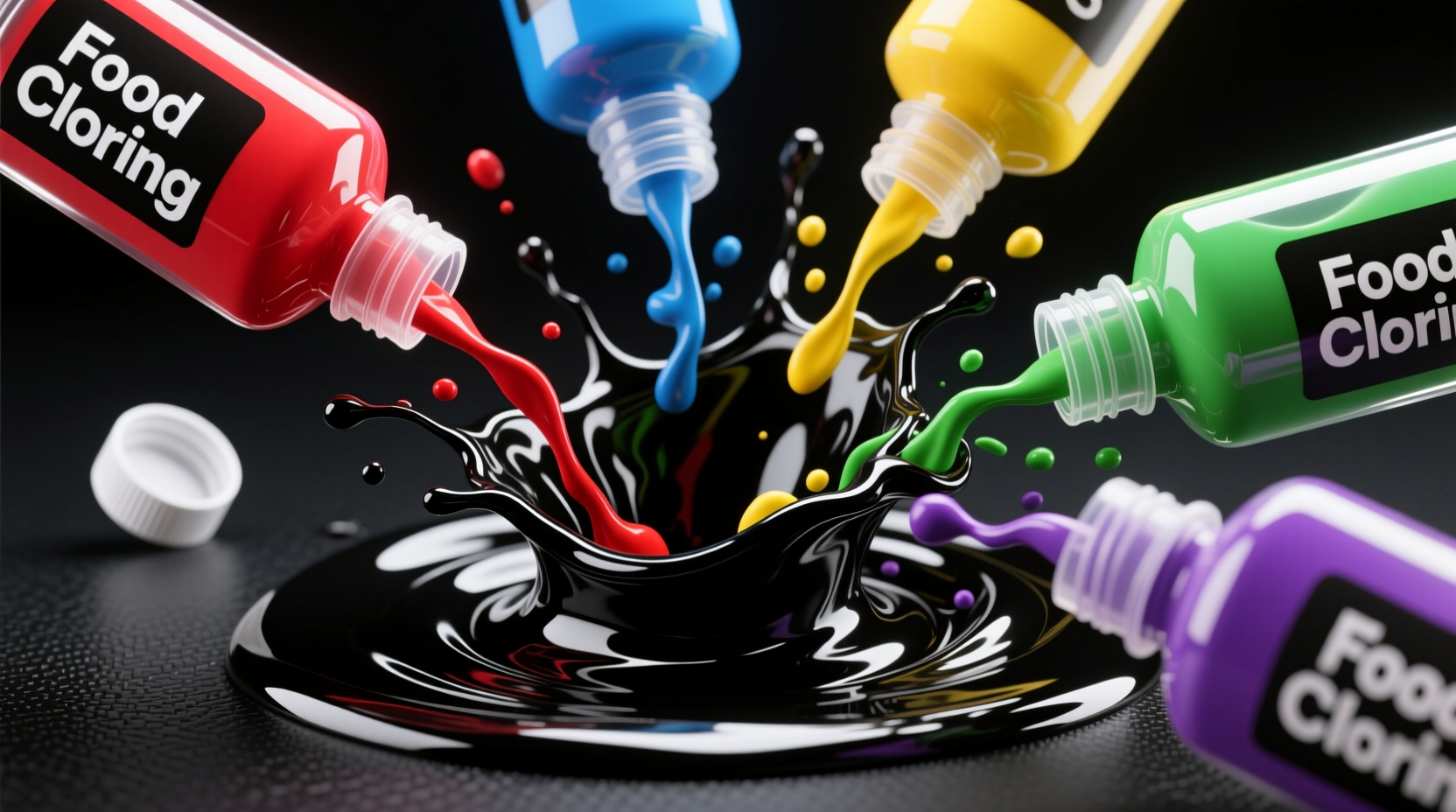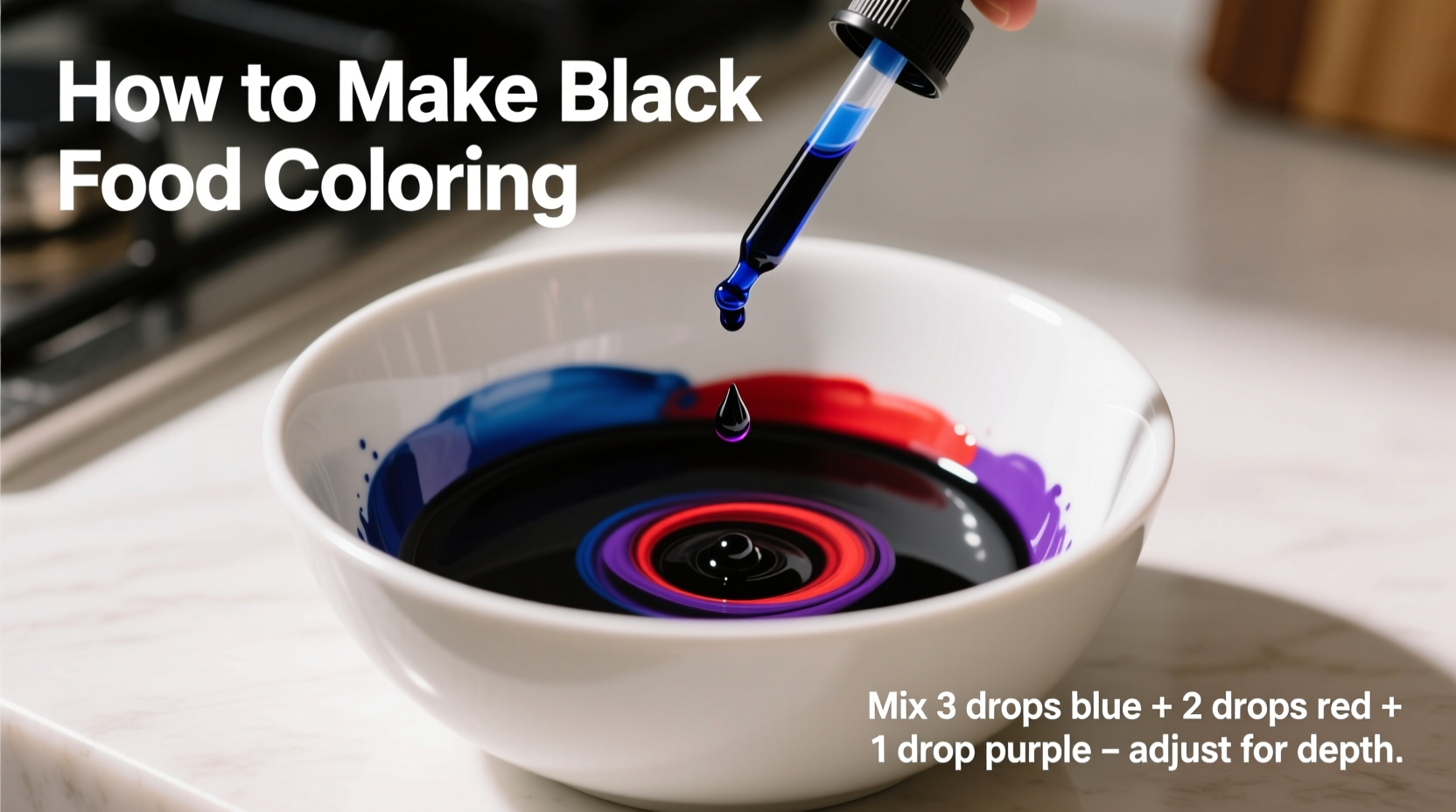Creating the perfect black hue for your baking projects can be surprisingly tricky. Unlike other colors, black isn't typically available as a standard food coloring option because of the complex chemistry involved in producing a true black shade that remains stable in food applications. This comprehensive guide reveals the most effective methods home bakers and food enthusiasts use to achieve the darkest possible black using common food coloring products.
The Science Behind Creating Black Food Coloring
Understanding color theory is essential when attempting to create black from primary colors. In the subtractive color model used for pigments and dyes:
| Color Model | Primary Colors | Black Creation Method | Effectiveness for Food |
|---|---|---|---|
| RGB (Light) | Red, Green, Blue | Additive: All colors combined | Not applicable to food dyes |
| CMY (Pigment) | Cyan, Magenta, Yellow | Subtractive: All colors combined | Moderate (cyan not standard in food) |
| Traditional Food | Red, Blue, Yellow | Mix equal parts of all three | Good (results in dark brown) |
| Professional Method | Blue, Red, Green | 3:2:1 ratio with concentrated gels | Best (closest to true black) |
Food coloring operates on a subtractive color model, where combining pigments absorbs more light. Standard food coloring sets don't include cyan and magenta (the technical primaries for CMY model), making true black difficult to achieve. Most home attempts result in a very dark brown or gray rather than pure black.
Step-by-Step Methods for Creating Black Food Coloring
Basic Liquid Food Coloring Method
This approach works well for beginners using standard liquid food coloring:
- Start with 15 drops of blue liquid food coloring
- Add 10 drops of red liquid food coloring
- Include 5 drops of green liquid food coloring
- Mix thoroughly in your frosting, icing, or batter
- Gradually add more coloring until desired darkness is achieved
For how to make black food coloring for icing, use less liquid to prevent thinning your frosting. Gel-based colors work better for icing applications as they're more concentrated.
Professional Gel Coloring Technique
Professional bakers achieve the darkest results using concentrated gel colors:
- Use Wilton's black gel color or Americolor Super Black for best results
- If unavailable, mix 3 parts blue gel, 2 parts red gel, and 1 part green gel
- Add coloring gradually using a toothpick to avoid over-saturation
- Let the color develop for 15-30 minutes as it often deepens over time

Contextual Limitations: When Different Methods Work Best
Understanding the limitations of creating black with food coloring is crucial for managing expectations. The effectiveness varies significantly based on your medium:
- Buttercream frosting: Requires more coloring due to dairy content; gel colors work best
- Chocolate-based recipes: Already dark, so less coloring needed to achieve black
- White cake batter: Needs substantial coloring; may affect texture if overused
- Royal icing: Most challenging medium; requires specialized black gel
The FDA's Center for Food Safety and Applied Nutrition notes that food dyes are generally recognized as safe (GRAS) when used in appropriate quantities, but recommends following manufacturer guidelines for maximum usage levels. Overuse can potentially cause staining or alter flavor profiles.
Troubleshooting Common Black Coloring Problems
Why Your Black Looks Brown or Gray
Several factors affect the final color outcome:
- Base ingredient color: Yellow cake batter will produce brown-black rather than true black
- Color concentration: Liquid dyes often lack sufficient pigment for true black
- Color development time: Black often deepens over several hours
- Lighting conditions: Colors appear different under various light sources
Advanced Techniques for Professional Results
For how to get true black with food coloring, consider these professional tips:
- Start with a chocolate base for naturally darker results
- Add tiny amounts of brown food coloring to deepen the shade
- Mix colors the day before for maximum color development
- Use activated charcoal (food-grade) for natural black coloring
- Consider specialized black gel coloring for critical applications
According to the International Association of Culinary Professionals, the development of concentrated gel food colors in the early 2000s revolutionized cake decorating, making previously difficult colors like black much more achievable for home bakers. Before this advancement, creating black required complex combinations and often resulted in unsatisfactory brown hues.
Safety and Natural Alternatives
When exploring how to make black food coloring naturally, consider these options:
- Activated charcoal: Provides dramatic black color; use food-grade only
- Squid ink: Traditional in Mediterranean cuisine for pasta and rice
- Black sesame paste: Creates dark gray to black hues with nutty flavor
- Black bean powder: Subtle darkening effect with earthy notes
Always verify that any natural coloring agent meets FDA safety standards for consumption. The University of California's Food Science Department cautions that natural alternatives often produce less intense colors and may affect flavor profiles more significantly than artificial dyes.
Practical Application Guide
Follow this workflow for best results when making black food coloring for baking projects:
- Determine your base recipe's starting color
- Select appropriate coloring method based on medium
- Start with small amounts of concentrated color
- Mix thoroughly and allow time for color development
- Adjust incrementally until desired shade is achieved
- Test on a small portion before committing to entire batch
Remember that black coloring often appears darker once set. For special occasions like Halloween or themed parties, prepare your colored elements 24 hours in advance to ensure color stability.











 浙公网安备
33010002000092号
浙公网安备
33010002000092号 浙B2-20120091-4
浙B2-20120091-4